A BRIEF HISTORY OF CRATER LAKE LAUNCHES
by Dan Pence
RiversWest,
April, 2004
Crater Lake, the deepest
and most pristine lake in the U.S., is a bright blue
jewel set on the spine of the Oregon Cascades. The
ultra clear water fills the hollow shell of former
Mt. Mazama, one of the tallest Cascade peaks until
it blew it’s top about seven thousand years ago in
a cataclysmic eruption. The six thousand foot plus
elevation Crater Lake has been host to fascinating
boat tours since 1921, providing a significant source
of income for the park concession.
The Launch Builders
Bus mechanic Paul Herron
began working at Crater Lake Park in 1922. Ten years
later he began to care for the hodgepodge collection
of Crater Lake tour boats. After piloting, maintaining
and managing the tour boats for 27 years, he suffered
a heart attack in 1959 and grudgingly retired. In
the mid-sixties Rudy Wilson, a boat builder with 25
years experience, ran the tour boat operation and
Paul Herron was back as a part-time consultant. 1966
was the year Paul and Rudy were sick of patching up
the odd collection of four little old tour boats the
park had haphazardly collected over the years. They
came up with an ambitious plan to create a boat building
operation on Wizard Island and build four 60 passenger
boats. The materials, hardware, engines and tools
were delivered by one of the then new Sikorsky Sky
Crane helicopters.
The Launch Design
The boats would be
39’ long, 11’6” wide, with 2’8” of draft, the hulls
based on a 1936 William
Atkin -- a highly noted east coast marine architect
-- cabin cruiser design. These would weigh 12,000
lbs, carry 60 passengers and run at 17-20 knots with
single big 280 horsepower gas engines. Built as open
launches so a roof or windshield wouldn’t obstruct
the view of the spectacular surroundings, the huge
mahogany runabouts would be built with highest quality
materials and workmanship. Passenger seating consisted
of 16 blue and white wooden benches separated by an
aisle, school bus fashion, for elegant simplicity.
The pilot station up forward was a big stainless steering
wheel and a couple gauges. Beside the pilot could
stand, facing the visitors, a park naturalist providing
commentary via a P.A. system.
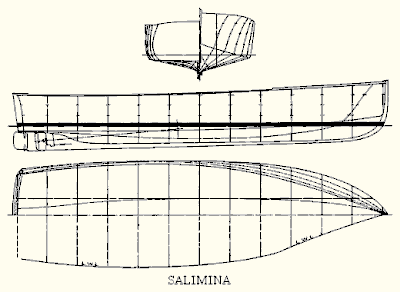
Building the Lake
Launches
The launching of the
Paul Herron, “brought to a close the
boat building project of Rudy H. Wilson who assembled
the boat from his own plans at the boathouse on Wizard
Island beginning two summers ago.” (Klamath Falls
Herald and News, July 7th, 1968). The National
Park Service approved the boat design later that summer
(in 2000 the boats received Coast Guard Certification).
After the christening Rudy got to work on the second
boat, pre-cutting many of the parts from patterns
of the first. The Rudy Wilson, also
assembled on Wizard Island was launched in August
28, 1971. These first boats cost $20,000 apiece.
To save time the bare
hulls of the remaining two boats, the Ralph
Peyton (named for the former Crater Lake Lodge
Company President) and Jim Griffen (the
Lodge Company president at the time) were built at
Rudy Wilson’s new boat works near the Portland Yacht
Club. The finished hulls were trucked to the rim,
then carried by helicopter down to Wizard Island.
Minus the engines, seats, drive shaft and propeller
the hulls were still near the 6,500 lb. payload limit
of the logging helicopter in the thin mountain air.
In 1983, despite superstition, the Jim Griffen
was renamed the Glen Happel, after the
new Crater Lake Lodge President.
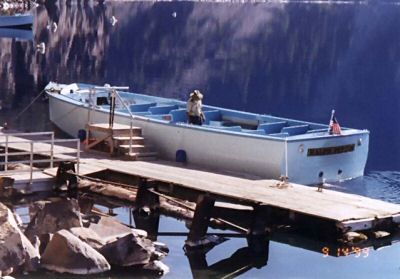
Service of the
Lake Launches
“They were our bread
and butter," related former Crater Lake Lodge president
Dick Gordon. Each boat typically ran three trips per
day all summer long. The tour boat fares were $12.50
for adults, $7.00 for kids. The lodge sold between
20,000 and 27,000 tickets every year in the late 1990’s.
Over the years, perhaps a million people toured the
Crater Lake in the four launches.
Service on the lake
was hard on the boats. Sudden williwaws and thunderstorms
surprised the tour boat fleet many times each season.
The recently christened Ralph Peyton
broke it’s mooring line during an August of ‘72 snowstorm.
The storm carried the empty launch across the lake
and smashed it onto jagged rocks, tearing a 4’ hole
in the bow. The seasonal inexperienced pilots bashed
the boats, usually accidentally, into docks, moorings,
boathouses and the rocky shores. In the mid-70’s Ralph
Peyton’s son was busted for water skiing across the
lake behind one of the tour boats one evening. Denny
Charlot of Tomahawk Island, did his best to keep the
boats in good shape from 1983 until 2001.
In 2001, the new lodge
concessionaire, Xanterra Corporation, decided the
old launches should be replaced and ordered new fiberglass
tour boats. The four retiring launches were lifted
out of the lake in the summer of 2003, overshadowed
by the sleek modern -- but distinctly less charming
and beloved -- replacements. The old lake launches
were trucked to a boatyard near Newport, to await
their fate.
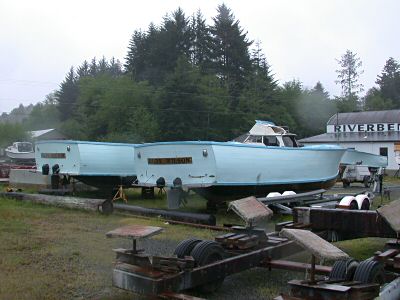
Photo by John Kohnen
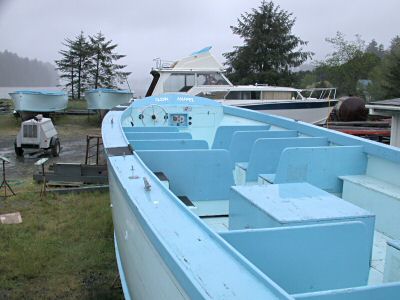
Photo by John Kohnen
Bringing the Launches
to Portland
In mid- March, 2004,
RiversWest,
a non-profit low-impact boating and boat building
organization in Portland, who organizes The Portland
Wooden Boat Show and has been providing a free demonstration
ferry service, heard the launches were available and
asked if they could be put to work in Portland for
a permanent river ferry service. Xanterra happily
agreed to donate the fleet to RiversWest rather than
see them destroyed. The best three of the boats are
being prepped for hauling to a Portland City yard
on the Eastbank of the Willamette River at the foot
of SE Salmon St. The 4th boat, the Glen Happel,
was found to be unneeded and in poor condition. It
will be salvaged for spare parts and useful pieces.
This may validate the superstitious.
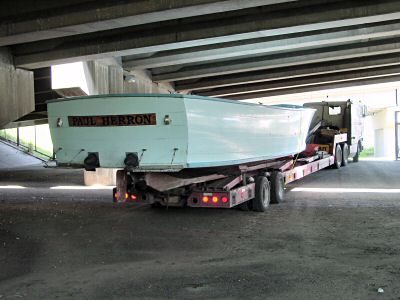
Photo by Peter
Wilcox
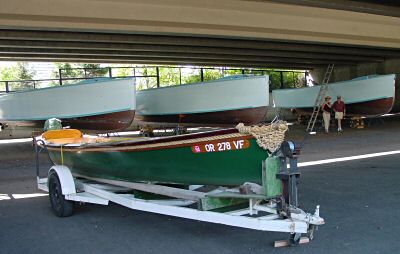
Photo by Peter Wilcox
With
the boats fitted with roofs to hold off Portland’s
winter drizzle and hot summer sun, slowed down to
a more appropriate and efficient speed, and innovatively
re-powered to protect the river’s water, people should
be able to shuttle between OMSI, the Maritime Museum,
shopping districts and residential areas, the Convention
Center, Rose Quarter and historic Oaks Amusement park,
all within a 5 mile stretch of river. Service is planned
to begin in the spring of 2005.
|

